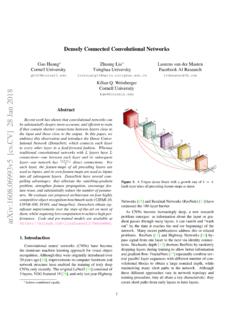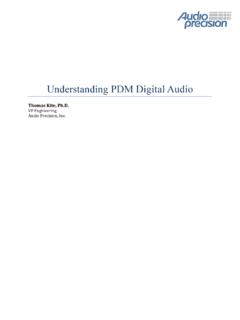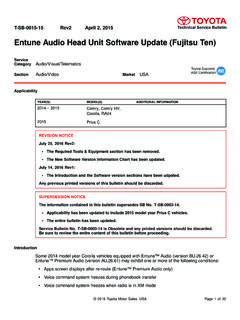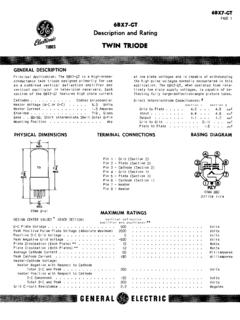Transcription of @google.com arXiv:1609.03499v2 [cs.SD] 19 Sep 2016
1 WAVENET: A GENERATIVEMODEL FORRAWAUDIOA aron van den OordSander DielemanHeiga Zen Karen SimonyanOriol VinyalsAlex GravesNal KalchbrennerAndrew SeniorKoray Kavukcuoglu{avdnoord, sedielem, heigazen, simonyan, vinyals, gravesa, nalk, andrewsenior, DeepMind, London, UK Google, London, UKABSTRACTThis paper introduces WaveNet, a deep neural network for generating raw audiowaveforms. The model is fully probabilistic and autoregressive, with the predic-tive distribution for each audio sample conditioned on all previous ones; nonethe-less we show that it can be efficiently trained on data with tens of thousands ofsamples per second of audio . When applied to text-to-speech, it yields state-of-the-art performance, with human listeners rating it as significantly more naturalsounding than the best parametric and concatenative systems for both English andMandarin. A single WaveNet can capture the characteristics of many differentspeakers with equal fidelity, and can switch between them by conditioning on thespeaker identity.}
2 When trained to model music, we find that it generates novel andoften highly realistic musical fragments. We also show that it can be employed asa discriminative model, returning promising results for phoneme work explores raw audio generation techniques, inspired by recent advances in neural autore-gressive generative models that model complex distributions such as images (van den Oord et al.,2016a;b) and text (J ozefowicz et al., 2016). Modeling joint probabilities over pixels or words usingneural architectures as products of conditional distributions yields state-of-the-art , these architectures are able to model distributions over thousands of random variables( 64 64 pixels as in PixelRNN (van den Oord et al., 2016a)). The question this paper addressesis whether similar approaches can succeed in generating wideband raw audio waveforms, which aresignals with very high temporal resolution, at least 16,000 samples per second (see Fig.)
3 1).Figure 1: A second of generated paper introducesWaveNet, an audio generative model based on the PixelCNN (van den Oordet al., 2016a;b) architecture. The main contributions of this work are as follows: We show that WaveNets can generate raw speech signals with subjective naturalness neverbefore reported in the field of text-to-speech (TTS), as assessed by human [ ] 19 Sep 2016 In order to deal with long-range temporal dependencies needed for raw audio generation,we develop new architectures based on dilated causal convolutions, which exhibit verylarge receptive fields. We show that when conditioned on a speaker identity, a single model can be used to gener-ate different voices. The same architecture shows strong results when tested on a small speech recognitiondataset, and is promising when used to generate other audio modalities such as believe that WaveNets provide a generic and flexible framework for tackling many applicationsthat rely on audio generation ( TTS, music, speech enhancement, voice conversion, source sep-aration).
4 2 WAVENETIn this paper we introduce a new generative model operating directly on the raw audio joint probability of a waveformx={x1,..,xT}is factorised as a product of conditionalprobabilities as follows:p(x) =T t=1p(xt|x1,..,xt 1)(1)Each audio samplextis therefore conditioned on the samples at all previous to PixelCNNs (van den Oord et al., 2016a;b), the conditional probability distribution ismodelled by a stack of convolutional layers. There are no pooling layers in the network, and theoutput of the model has the same time dimensionality as the input. The model outputs a categoricaldistribution over the next valuextwith a softmax layer and it is optimized to maximize the log-likelihood of the data the parameters. Because log-likelihoods are tractable, we tune hyper-parameters on a validation set and can easily measure if the model is overfitting or LayerHidden LayerHidden LayerOutputFigure 2: Visualization of a stack of causal convolutional main ingredient of WaveNet are causal convolutions.
5 By using causal convolutions, wemake sure the model cannot violate the ordering in which we model the data: the predictionp(xt+1|x1,..,xt)emitted by the model at timesteptcannot depend on any of the future timestepsxt+1,xt+2,..,xTas shown in Fig. 2. For images, the equivalent of a causal convolution is amasked convolution (van den Oord et al., 2016a) which can be implemented by constructing a masktensor and doing an elementwise multiplication of this mask with the convolution kernel before ap-plying it. For 1-D data such as audio one can more easily implement this by shifting the output of anormal convolution by a few training time, the conditional predictions for all timesteps can be made in parallel because alltimesteps of ground truthxare known. When generating with the model, the predictions are se-quential: after each sample is predicted, it is fed back into the network to predict the next models with causal convolutions do not have recurrent connections, they are typically fasterto train than RNNs, especially when applied to very long sequences.
6 One of the problems of causalconvolutions is that they require many layers, or large filters to increase the receptive field. Forexample, in Fig. 2 the receptive field is only 5 (= #layers + filter length - 1). In this paper we usedilated convolutions to increase the receptive field by orders of magnitude, without greatly increasingcomputational dilated convolution (also called`a trous, or convolution with holes) is a convolution where thefilter is applied over an area larger than its length by skipping input values with a certain step. It isequivalent to a convolution with a larger filter derived from the original filter by dilating it with zeros,but is significantly more efficient. A dilated convolution effectively allows the network to operate ona coarser scale than with a normal convolution. This is similar to pooling or strided convolutions, buthere the output has the same size as the input.
7 As a special case, dilated convolution with dilation1yields the standard convolution. Fig. 3 depicts dilated causal convolutions for dilations1,2,4,and8. Dilated convolutions have previously been used in various contexts, signal processing(Holschneider et al., 1989; Dutilleux, 1989), and image segmentation (Chen et al., 2015; Yu &Koltun, 2016).InputHidden LayerDilation = 1 Hidden LayerDilation = 2 Hidden LayerDilation = 4 OutputDilation = 8 Figure 3: Visualization of a stack ofdilatedcausal convolutional dilated convolutions enable networks to have very large receptive fields with just a few lay-ers, while preserving the input resolution throughout the network as well as computational this paper, the dilation is doubled for every layer up to a limit and then repeated: ,2,4,..,512,1,2,4,..,512,1,2,4,.., intuition behind this configuration is two-fold.
8 First, exponentially increasing the dilation factorresults in exponential receptive field growth with depth (Yu & Koltun, 2016). For example each1,2,4,..,512block has receptive field of size1024, and can be seen as a more efficient and dis-criminative (non-linear) counterpart of a1 1024convolution. Second, stacking these blocks furtherincreases the model capacity and the receptive field DISTRIBUTIONSOne approach to modeling the conditional distributionsp(xt|x1,..,xt 1)over the individualaudio samples would be to use a mixture model such as a mixture density network (Bishop, 1994)or mixture of conditional Gaussian scale mixtures (MCGSM) (Theis & Bethge, 2015). However,van den Oord et al. (2016a) showed that a softmax distribution tends to work better, even when thedata is implicitly continuous (as is the case for image pixel intensities or audio sample values).
9 Oneof the reasons is that a categorical distribution is more flexible and can more easily model arbitrarydistributions because it makes no assumptions about their raw audio is typically stored as a sequence of 16-bit integer values (one per timestep), asoftmax layer would need to output 65,536 probabilities per timestep to model all possible make this more tractable, we first apply a -law companding transformation (ITU-T, 1988) tothe data, and then quantize it to 256 possible values:f(xt) = sign(xt)ln (1 + |xt|)ln (1 + ),3where 1< xt<1and = 255. This non-linear quantization produces a significantly betterreconstruction than a simple linear quantization scheme. Especially for speech, we found that thereconstructed signal after quantization sounded very similar to the ACTIVATION UNITSWe use the same gated activation unit as used in the gated PixelCNN (van den Oord et al.)
10 , 2016b):z= tanh (Wf,k x) (Wg,k x),(2)where denotes a convolution operator, denotes an element-wise multiplication operator, ( )isa sigmoid function,kis the layer index,fandgdenote filter and gate, respectively, andWis alearnable convolution filter. In our initial experiments, we observed that this non-linearity workedsignificantly better than the rectified linear activation function (Nair & Hinton, 2010) for modelingaudio AND SKIP CONNECTIONS1 1 ReLUReLU1 1 DilatedConvtanh + 1 1+SoftmaxResidualSkip-connectionsk LayersOutputCausalConvInputFigure 4: Overview of the residual block and the entire residual (He et al., 2015) and parameterised skip connections are used throughout the network,to speed up convergence and enable training of much deeper models. In Fig. 4 we show a residualblock of our model, which is stacked many times in the an additional inputh, WaveNets can model the conditional distributionp(x|h)of the audiogiven this input.
![arXiv:0706.3639v1 [cs.AI] 25 Jun 2007](/cache/preview/4/1/3/9/3/1/4/b/thumb-4139314b93ef86b7b4c2d05ebcc88e46.jpg)

![arXiv:1301.3781v3 [cs.CL] 7 Sep 2013](/cache/preview/4/d/5/0/4/3/4/0/thumb-4d504340120163c0bdf3f4678d8d217f.jpg)












